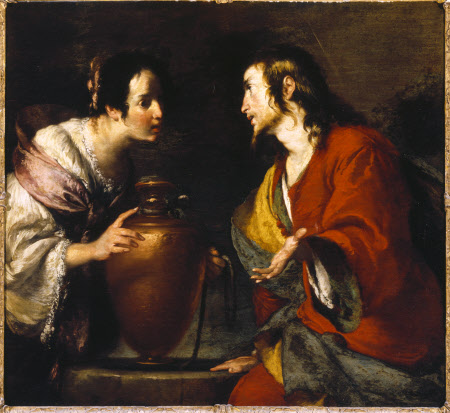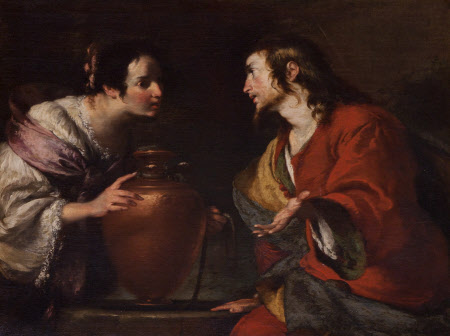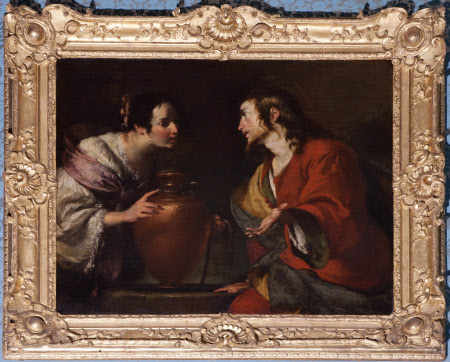Christ and the Woman of Samaria
Bernardo Strozzi (Genoa 1581 - Venice 1644)
Category
Art / Oil paintings
Date
1630 - 1644
Materials
oil on canvas
Measurements
1100 x 1150 mm
Place of origin
Italy
Order this imageCollection
Kedleston Hall, Derbyshire
NT 108872
Caption
The woman from Samaria, a town whose inhabitants the Jews considered outcasts, was the first person to whom Christ revealed himself as the Messiah, thus demonstrating that his mission was not to the Jews alone. As related in the biblical gospel of John (4:1-30), Christ paused at Jacob's Well on the way from Judaea to Galilee and asked for a drink. As an adulteress and rejected by her own people, the woman was astonished but Christ said: "Everyone who drinks the water will be thirsty again, but whoever drinks the water I shall give him will never suffer thirst anymore." Although this picture and its companion represent successive revelations of Christ's divinity and mission, they were not originally intended as a pair, though bought, framed, and hung as such by Sir Nathaniel Curzon, 1st Lord Scarsdale (1726 - 1804) in the Drawing Room at Kedleston, along with other acquisitions from the amateur art dealer, William Kent.
Summary
Oil painting on canvas, Christ and the Woman of Samaria by Bernardo Strozzi (Genoa 1581 - Venice 1644). Known as ‘Il Prete Genovese’ or ‘Il Cappuccino’, from his original vocation as a Capuchin friar, Strozzi left the Order in 1630 and moved to Venice, where he became the chief formative influence upon the local school of painting. His particular forte is showing the interaction of a few half-length figures. The positions of this picture and its pendant (NT 108873), acquired at a sale of William Kent’s in 1758, are indicated in Adam's sectional drawing of the Drawing Room of around 1765.
Full description
Although bought, framed, hung, previously exhibited, and presented here, as pendants, the two Strozzi pictures are only factitiously linked. As can be seen on closer inspection (and it must be admitted that at Kedleston they have always hung high, as overdoors, so that this is not normally possible), they do not balance one another either compositionally (Christ and the Woman of Samaria has only two figures, seen close to, fully lit, and rather from below; St John the Baptist interrogated has four, slightly more distanced, in strong chiaroscuro, and seen somewhat from above), thematically (save in their common depiction of interrogation), or in handling (in the St John the Baptist interrogated Strozzi's characteristic style and physiognomies are not yet fully present, and the paint is handled in more hesitant dabs, or macchie, as compared with the more mature and fluidly painted Christ and the Woman of Samaria. All this further points to the fact that the two pictures must have been painted some distance apart in time. The St John the Baptist interrogated is the earlier of the two, painted when Strozzi's style was not yet fully formed, and when his handling was still tentative. Symptomatic of this is the fact that, whereas Luisa Mortari could allude to a number of other versions of the Christ and the Woman of Samaria, she could cite no other of the John the Baptist interrogated, which she was inclined - evidently not from personal inspection, since she situates both paintings in London - to adjudge a work of Strozzi's circle, rather than one by the artist himself . Supporting the ascription to Strozzi himself of the St John the Baptist Interrogated, and its somewhat earlier dating, is its strong similarity, in both handling and composition (though the figures are more spread out), to the Act of Mercy:Giving Drink to the Thirsty, whose prime version (the John & Mable Ringling Museum, of Art, Sarasota) Mortari dates to c.1618-20, and of which she lists four other autograph versions . The Christ and the Woman of Samaria, a composition of which she was able to locate only the present picture and the version in the Bob Jones University Collection, Greenville, she would seem to date only a little later, whereas Michael Milkovich would date the latter version to "the last Genoese years" (i.e. before Strozzi's departure for Venice in late 1630 or early 1631) . The drawing in Budapest that Fenyö connected with this painting, Mortari rightly identifies as for a quite distinct composition ; whilst she hesitates whether to make the freer and much more lyrical treatment of the subject (in the collection of Dr D. Hannema, Het Nijenhuis, Heino), one of Strozzi's last Genoese works, or one of the earliest Venetian ones, so strongly does it seem to her to reflect the influence (already drawn attention to by Fenyö) of such Venetian artists as Palma Giovane . Homan Potterton, when exhibiting the present picture in 1979, preferred to date it to early in Strozzi's Venetian career . A bill in the Kedleston archives shows that Nathaniel Curzon (later 5th Bt, and 1st Lord Scarsdale) bought these two pictures at an auction of pictures assembled by William Kent (the marchand-amateur, not the architect) in 1758. A complete catalogue of this sale has not yet been located . They are, however, written into one of the two drawings of 1759/60 entitled 'Section of One End of the With-Drawing' at Kedleston, that for the south wall, as by 'Prete Genovese' (Strozzi's sobriquet, from his original priestly vocation). This was one of the hangs designed by Robert Adam in emulation of James 'Athenian' Stuart's, about which he had previously been so sarcastic . It includes not only pictures that Curzon had bought at auction, but others that he had sent Kent to Italy to buy at source on his behalf in 1758-59 . One reason for Curzon's having dispatched Kent to Italy was the great difficulty in obtaining Italian paintings of any quality in the London auctions. To judge by Houlditch's transcripts from London sale catalogues between 1711 and 1759, the overwhelming majority of the pictures sold were Flemish and Dutch, and many, if not most, of the Italian pictures that featured in them were copies, and by or after a handful of the same artists. Strozzi's name occurs in only one other sale, also one of Kent's, in 1759. Kent's annual sales, from 1757 to 1759, were one of the few exceptions to this dearth; and it must have been because Sir Nathaniel recognised that Kent had good sources of supply in Italy, that he sent him out there to buy on his behalf. Once in Italy, Kent made - or tried to make - purchases in Genoa, Bologna, and Florence (but not - apparently - Naples, or Rome, and only half-heartedly in Venice: he may have lacked contacts in these cities and have thought that they were, with all the Grand Tourists, a seller's rather than a buyer's market; tourists visited the three cities he exploited only en passant). He attempted, without success, to buy pictures from the Sampieri collection in Bologna as did Richard Dalton the same year for Sir James Lowther, and again in 1761 for Sir Richard Grosvenor (it was in only finally to be acquired en bloc by Eugène de Beauharnais in 1811), did buy a purported Van Dyck (called subsequently, but not by him, Sir Peter Rycaut) in Genoa, and involved himself in tortuous negotiations for pictures from the Gerini and Arnaldi collections in Florence. He was outbid by (Margaret Rolle, dowager) Countess of Orford for the former, and was either unaware of the fact, or did not disclose to Curzon, that he had been beaten by Henry Hoare 'the Magnificent' to the greatest prizes of the latter: the Marchese Niccolò Maria Pallavicini guided to the Temple of Virtù by Maratta, and a pair of huge and splendid Landscapes by Gaspard Poussin (Dughet) - all three still at Stourhead . The pool was further muddied by the fact that he was buying pictures on his own account, for what turned out to be a disastrous sale at Langford's in 1759 (called that of the collection of Signor Borri of Florence, deceased), and by his apparently being unaware that certain of the marchese Gevini's pictures had previously been in the collection of the marchese Arnaldi. So that, although he announced two sets of purchases to Sir Nathaniel - the first (after passing through Florence) from Venice, on 15th August 1758, of nine pictures from undisclosed sources; and the second, from Florence itself, on 2nd October 1758, of 17 pictures from the collection there of the Marchese Arnaldi - it would in fact appear that all of the first nine, bar the Van Dyck from Genoa, also came from the Arnaldi collection, itself the receptacle of the pictures commissioned or collected by the Marchese Niccolò Maria Pallavicini (1650-1714) . Some (notably a supposed 'Poussin') were adjudged dud on arrival, others (in particular, paintings purportedly by Raphael, Annibale Carracci, or Sacchi) have been demoted since, whilst others again have been sold. Two of his Florentine purchases, however, continue to adorn the same room as the pair of Strozzis, even if their exact attribution is still a matter of debate: the huge Orlando rescuing Olympia over the chimneypiece (which the original owner believed to be by Pietro Testa, but which Kent, not unshrewdly, attributed to Annibale Carracci -it is now more generally thought to be by Lodovico Carracci), and the Cupid asleep on the Island of Paphos (which was ascribed to Guido Reni, an ascription to which - after alternative attributions to Orazio Riminaldi and Sisto Badalocchio - opinion may be beginning to return) . Whilst the room is dominated by a pair of pictures that - ironically - were bought by Curzon in one of Kent's sales, before the latter ever went to Italy on his behalf: Benedetto Luti's masterpieces, the Christ in the House of Simon and God condemning Cain for the murder of Abel . William Kent's efforts on Curzon's behalf in Italy seem, however, to have finally discouraged him from dabbling in dealing in paintings. Richard Dalton - scarcely a disinterested rival - had said of him, when they were both in Florence angling for pictures in 1758, that: "having married an alderman's daughter with a large fortune, [he] has taken it in his head to turn dealer in both Pictures and Drawings, and in my humble opinion, as he has not the least genius in that way, will pay for his learning in the end" . The last of his letters to Curzon, dated from Naples 20 May 1759, responding to the discouraging news of the 'Poussin' that he had bought for his patron turning out to be spurious, and of the failure of his sale at Langford's, resignedly says: "I am determined never to play this game more" - and indeed, no more sales in his name are recorded. In June 1760 his wife was reputed to have gone mad in Florence. Nonetheless, he clearly continued to deal in drawings if not in paintings, since in early 1761 James Adam wrote to his brother Robert to say that Kent had bought up the collection of drawings formed by Baron Stosch, with whom he had long been in treaty over buying his collection of antique coins and gems. And it must have been when he returned from Florence to London that he took with him the remarkable album of drawings by Fra Bartolomeo that had belonged to the virtuoso and collector Francesco Gabburri (1675-1742), which caused such a sensation when they re-emerged and were sold at Sotheby's on 20 November 1957, and are now to be found divided between most of the major print-rooms in the world. (i) Luisa Mortari, Bernardo Strozzi, Rome, 1966, p.144 & fig. 276 (only the Christ and the Woman of Samaria reproduced). (ii) Mortari, op.cit., pp.38, 89, 155, 167, 172 & 174; figs. 278-81, 283, & 286 (another sold at Christie's, 9 Dec. 1988, lot 22); cf. exh. cat. Bernardo Strozzi:Paintings & Drawings, University Art Library, Binghamton, 1967, no.12. (iii) Mortari, op.cit., pp.38, 136-37 & 144 and figs. 275 & 276; exh. cat. cit. no.26. (iv) J. Fenyö, 'Contributo ai rapporti artistici tra Palma il Giovane e Bernardo Strozzi', in Acta Historiae Artium Academiae Scientarium Hungaricae, vol.V (1958), p.146; Mortari, op.cit., pp.144 & 219 and fig. 472. (v) Mortari, op.cit., pp.38 & 138 and fig. 311. (vi) Cf. exh.cat. Venetian Seventeenth Century Painting, National Gallery, London, 1979, no.22. (vii) For whom, see esp. John Fleming, 'Mr. Kent, Art Dealer, and the Fra Bartolommeo Drawings', The Connoisseur, vol.LXLI, 1958, p.227. [INSERT REF. to further inf. from Guercino drawings, exh. cat. preface]/ (vii) Houlditch's transcription, in the second of his two volumes of London sale transcriptions, 1711_59, in the National Art Library (86.00.18 & 19) is unusual in only noting five lots from the sale, three of which were, however, bought by Curzon (only one of which is now at Kedleston); it seems hard to see why he should have omitted the rest of Curzon's purchases. It is Leslie Harris (to whom I am most grateful for the benefit of this and much other information from the Kedleston archives, which he has put into order over the last thirty years) who, by matching up the bill for the lots bought at the sale (which has their numbers only), with prices subsequently put against pictures by the 2nd Lord Scarsdale, has succeeded in pinpointing the Strozzis and other purchases at it. (viii) Cf. exh.cat. Robert Adam and Kedleston (by Leslie Harris & Gervase Jackson-Stops), The Heinz Gallery, RIBA, London, and sundry U.S. locations, 1987ff. This particular drawing is not included in the catalogue, but Adam's design for the ceiling of the Drawing Room, signed and dated 1759, is no. 24. His Section of the Chimney Side of the WithDrawing Room is signed and dated 1760. Adam's drawings are very functional, compared with Stuart's appealing watercolours for a State Room (cat.nos. 11-14), but in which, Adam charged, the latter had: "wanted to fitt frames for Sir Nathaniel's pictures, but not having - or rather, I suppose, not being willing - to confine his great genius to the sizes of the pictures, he cutts 3 foot off the length of the best pictures, and 2 foot off the height of others, to make them answer, and draws all the pictures and colours them in his drawings. But they move pity rather than contempt". (ix) It is to be hoped that the full picture of William Kent's activities on behalf of Sir Nathaniel Curzon will one day emerge from the long-awaited book on Kedleston and its collections by Leslie Harris, who has done so much to bring this and many other things to light from the Kedleston archives, and has been most generous in communicating his discoveries to the National Trust. Some confusion has, however, been caused by an earlier misreading of William Kent's signature as 'Willkens', thus conflating him with Ralph Howard's agent, the abbé William Wilkins (e.g. in Francis Russell's 'Securing the Future', Country Life, 23 July 1987, pp.98-99. (x) Cf. letter of Horace Mann .... (xi) I am greatly indebted for this information to Stella Rudolph (letters of 11 March, 2-4 May, & 24 August 1994), whose researches into the Pallavicini and Arnaldi collections, published as in 1994 [see Note 13], have enabled her to identify a number of previously unsuspected paintings at Kedleston as coming from this source, as well as revealing the full importance of the Marchese Niccolò Maria Pallavicini himself. (xii) Cf. Stella Rudolph, Niccolò Maria Pallavicini:l'ascesa al Tempio della Virtù attraverso il Mecenatismo, Rome, 1994, [ ]. (xiii) William Kent's sale, 1757 (Houlditch ms. transcriptions, National Art Library, vol.I, p.480, lots 55 & 56). Curzon's greatest purchase from Kent, Luca Giordano's Triumph of Bacchus, with Ariadne, painted in Florence, was in the same sale, lot 54. (xiv) John Fleming, art.cit. (xv) John Fleming, Robert Adam and his Circle, 1966, p.279. (adapated from author's pre-publiction/undeited version, Alastair Laing, In Trust for the Nation, exh. cat., 1995)
Provenance
William Kent (fl. 1742-1761) sale, London, February, 1758, lots 36 & 35, bought for £12 & £21 by (Sir) Nathaniel Curzon (1726—1804; succeeded as 5th Bt, Nov. 1758; created 1st Baron Scarsdale, April 1761); and thence by descent until bought with part of the contents of Kedleston with the aid of the National Heritage Memorial Fund in 1987 when the house and park were given to the National Trust by Francis Curzon, 3rd Viscount Scarsdale (1924-2000)
Credit line
Kedleston Hall, The Scarsdale Collection (acquired with the help of the National Heritage Memorial Fund and transferred to The National Trust in 1987)
Makers and roles
Bernardo Strozzi (Genoa 1581 - Venice 1644), artist
Exhibition history
In Trust for the Nation, National Gallery, London, 1995 - 1996, no.47b
References
Kedleston Hall, Derbyshire, 1769 Catalogue of the Pictures, Statues, &c. at Kedleston, 1769, p.5 Matteucci 1956 A.M. Matteucci, 'Note all' attività genovese di B. Strozzi', Emporium, 1956, p.195 Fenyò 1958 I. Fenyò, 'Contributo ai rapporti artistici tra Palma il Giovane e Bernardo Strozzi', Acta Historiae Artium Academiae Scientiarum Hungariae, vol.V (1958), p.143 Mortari 1966 Luisa Mortari, Bernardo Strozzi, Rome, 1966, p.144 & fig.266 Kedleston Hall, Derbyshire, 1977 [Guide: 2nd Viscount Scarsdale] 1977 , (and subsequent edns.), p.8 Kedleston Hall, Derbyshire, 1988 [The National Trust], 1988 , (and subsequent edns.), p.26, nos. 184 & 183


